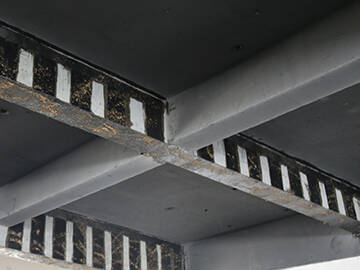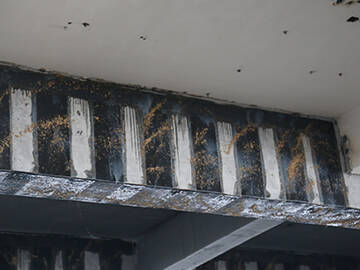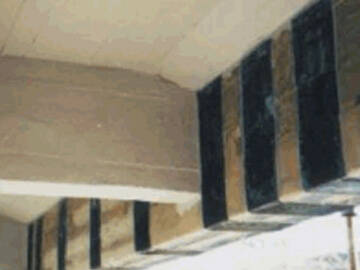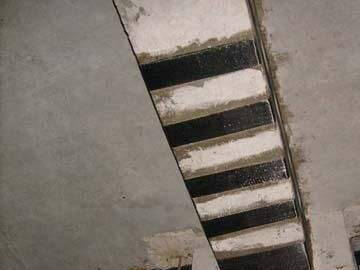Unidirectional Carbon Fiber Fabric
Change the Structural Function
Carbon fiber composite material; concrete beam; structural reinforcement strengthening


Project Overview
An idle teaching building in Hexi District was converted into an office building, and some classrooms are now converted to equipment rooms according to functional needs. The shear capacity of the beam meets the requirements, and the original flexural capacity is 204.3kN•m. The reinforced flexural capacity of the beam is required to be 260kN•m.
When using unidirectional carbon fiber materials to reinforce beams, plates and other bending members, the following basic assumptions should be met:
@Should meet the basic assumptions of the current national standard "Code for Design of Concrete Structures" for the bearing capacity of the front section:
@The stress and strain relationship of fiber composites is linear; considering that the live load acting on the reinforced structure is basically removed, the influence of the secondary force is not considered
@Before reaching the ultimate state of flexural bearing capacity, there will be no bond peeling damage between the reinforcement material and the concrete.
Three layers of 250mm wide and 0.167mm thick unidirectional carbon fiber cloth are selected to meet the requirements of the equipment room.
The project uses Horse HM30 unidirectional carbon fiber cloth, which is Japanese Toray carbon fiber yarn (12K).
Considering the special construction environmental factors of the project, unloading should be carried out during reinforcement. Before reinforcement, remove the flour and sundries on the board.
During the reinforcement of the project, the protective layer should be cut to the base surface of the structural layer before proceeding to the next step.


Brief introduction of technical characteristics of unidirectional carbon fiber cloth structure reinforcement
Carbon fiber structural reinforcement technology refers to the use of high-performance adhesives to stick unidirectional carbon fiber cloth on the surface of building structural members, so that the two work together to improve the bearing capacity (bending and shearing) of structural members. This achieves the purpose of strengthening and strengthening the building. Carbon fiber reinforced polymer (Carbon Fibre Reinforced Poly-mer referred to as CFRP, also known as carbon fiber reinforced plastic) is made of epoxy resin bonded with high tensile strength carbon fiber bundles. The use of unidirectional carbon fiber cloth reinforcement has the following advantages:
(1) High strength and high efficiency due to the excellent physical and mechanical properties of carbon fiber materials. In the process of strengthening the concrete structure, it can make full use of its high strength and high modulus characteristics to improve the bearing capacity and ductility of the nest structure and components, and improve its mechanical performance. To achieve the purpose of efficient reinforcement.
(2) It has excellent corrosion resistance, durability and good fatigue resistance. Durability and corrosion resistance are important indicators for evaluating the quality of a structural engineering. Especially for some buildings with special requirements, anti-corrosion and radiation protection (aging resistance) have become important considerations for this type of structure design. The carbon fiber cloth material itself and the composite formed with the bonding material have good corrosion resistance under various environmental conditions. It can resist the effects of acid, alkali, salt and atmospheric corrosion that are often encountered in buildings, and also has good fatigue resistance. Solve the chemical corrosion problem encountered by other reinforcement methods.
(3) Do not increase the weight and volume of the components. Carbon fiber cloth is light in weight and thin in thickness. The reinforced and repaired components basically do not increase the weight and size of the original structure, and will not reduce the use space of the building. This is undoubtedly very important to the economy and society of "inches of land" .、
(4) Wide application. Because carbon fiber cloth is a flexible material and can be cut arbitrarily, this reinforcement technology is widely used in various structural types and various parts of various structural shapes, without changing the structural shape and without affecting the structural appearance.
(5) Simple construction. As there is no wet work in the field construction, no large construction equipment, no fixed equipment on site, and less space for construction. Under the premise of ensuring construction quality and no accidental interference, the time required under the same conditions is less than half of the time required by the steel plate reinforcement method .
(6) The construction quality is easy to guarantee. The construction and operation of carbon fiber cloth reinforced concrete structure technology is convenient. Under normal construction conditions, the effective bonding area of carbon fiber cloth can basically reach 100%, and on-site inspection is convenient. Even if there is a small hollow drum, it can be remedied by needle injection, and the construction quality can be effectively guaranteed.
Carbon fiber reinforcement technology is suitable for the reinforcement and repair of various structure types and various structural parts, such as beams, slabs, columns, roof truss.
For structures such as bridge piers, bridges, cylinders, shells, etc., the strength level of the base concrete is required to be no less than 1,000 C15. In addition, some mechanical properties of brick masonry can also be reinforced with carbon fiber.
Conclusion
Through the construction operation of an office building project example, the author deeply realized the advantages of carbon fiber cloth structural reinforcement technology. During the construction of this project, under the premise of ensuring safety, only simple scaffolding was used, and the carbon fiber cloth cutting was very convenient. It can be planted and cut at will according to the shape and size, and can be passed through the shelter of various supports, which is very convenient for construction. In addition, since the construction was completed and the building was put into use, the reinforced concrete structure has met the owner's safe use requirements and has been well received by the owner.
In recent years, carbon fiber reinforcement technology has been widely used in reinforced concrete beams, slabs, columns and shear wall structures in bridges, tunnels and industrial and civil buildings. The product has excellent performance, simple operation, safety and reliability. Compared with traditional methods, there are greater economic, social and environmental benefits. Carbon fiber reinforced concrete structure technology is a model of successful application of Jiangwo technology composite materials in the field of civil engineering, and it is a reinforcement technology worth promoting. With the continuous progress of construction technology, carbon fiber technology should have broad development prospects.